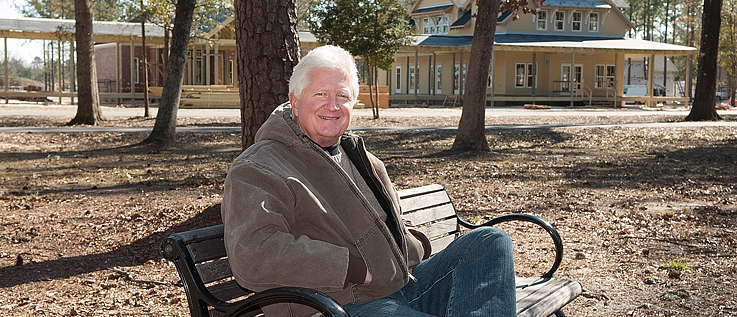The River Bluffs development in Castle Hayne, with its generous stands of evergreen and deciduous trees sloping toward the banks of the northeast Cape Fear River, feels geographically and conceptually distinct from the average subdivisions that pepper the Cape Fear landscape. Sited for energy-efficient houses clustered among more than 100 acres of open space thick with trees and crisscrossed with walking trails, local developer Burrows Smith is modest when he explains his vision.
“We’ve pushed the envelope a little bit. I wouldn’t say we’re being pioneers. It’s more of a throwback to the way things used to be done,” Smith said.
Motivated to preserve the natural beauty of the 313-acre site overlooking the northeast Cape Fear River, Smith is creating a community that connects residents to the land and the people around them. He relied on site development and building techniques more commonly practiced in the past, but abandoned in recent years.
“So many times, it’s like following the leader and you’re not thinking outside the box. You just do what everybody else is doing, and a lot of times, that’s not better. It’s just what everybody else is doing,” Smith said.
His stormwater management approach is certified as Low Impact Development (LID) by New Hanover County and the state. More than one-third of the site will be protected as parks, walking trails and other green spaces, with many of the enclaves of trees and open grassy areas doubling as infiltration basins that soak up stormwater before it runs into the river.
LID-certified projects capture and clean water that falls on the property instead of allowing it to discharge into nearby water sources untreated. Nitrogen, phosphates and other pollutants accumulate in stormwater, and when developments utilize curb-and-gutter systems with stormwater ponds, Smith said the pollutants either sink to the bottom and seep out through the earthen walls of a pond, or float on the surface of the water, ready to be washed into a nearby stream or river during the next rain event. Instead of concrete curbs and gutters, the tree-rimmed roadways of River Bluffs are lined with vegetated swales that absorb and filter rainwater and return it to the roots of indigenous plants on the property.
“Everything we do is to slow the water down and put it back in the ground right here, instead of down there by the river,” Smith said. “My goal is to not ever have any water running to the northeast Cape Fear River from this site.”
Stormwater management practices extend to each lot at River Bluffs by preserving trees and using permeable pavement and downspouts that feed away from driveways into grassy stretches or an infiltration system.
The houses built on those lots are also held to a more traditional yet sustainable approach. Every house in the subdivision is required to have a wide front porch and big overhangs to keep residents cool during the summer and capture radiant heat from the sun during the winter.
“It’s just a simple design that works,” Smith said.
Smith’s vision requires a little more work from the builders and engineers involved in the project.
“I’ve been out here since 2007, walking around and planning all this, so I love all these trees. It’s like my enchanted forest out here. It does make you proud, when you can do something that’s different, but people appreciate it,” Smith said.
River Bluffs was one of two local development projects to earn top honors during the 2015 Lower Cape Fear Stewardship Development Awards luncheon last week. Criteria included a thorough evaluation of site development, natural resources preservation, habitat protection and restoration, sustainable building techniques, reuse and revitalization, community education, public outreach and more.
A few miles downriver from Smith’s site, protection of the natural and historic environment also underpinned development decisions behind the new Union Station building on the Cape Fear Community College downtown campus, the other winner of top honors.
Because the three-acre site at the corner of Front and Red Cross streets is only a few blocks from the Cape Fear River, Ken Pearce, Cape Fear Community College director of institutional services, said the college felt obligated to prevent stormwater from running off into the river.
“We’re so close to the river, so we wanted to be good stewards of the environment,” Pearce said.
An underground cistern captures water that falls on Union Station, which is used to irrigate the green space behind the building, planted with water-efficient plants. A pedestrian path along the old Atlantic Coast Railroad rail bed was laid with pervious pavement, which also absorbs and filters stormwater and reduces runoff.
The renovation of Old Topsail High School in Hampstead and construction of the Hackney Dental Office in Wilmington and Westgate Nature Park in Leland also earned accolades during the 2015 awards ceremony. LS3P Associates was honored as a Stewardship Champion.
email [email protected]




